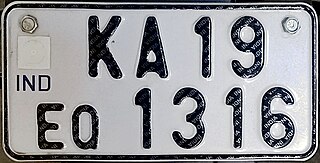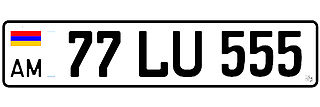
Number plates of the Kingdom of Eswatini (formerly the Kingdom of Swaziland) are similar in size to their South African counterparts and are displayed on both front and back of the vehicle.

Number plates of the Kingdom of Eswatini (formerly the Kingdom of Swaziland) are similar in size to their South African counterparts and are displayed on both front and back of the vehicle.

The current design, introduced in 2010, closely resembles the number plates used in South Africa, purportedly in an attempt to reduce hijacking of Swazi-registered cars in that country. [1] The introduction of these plates is somewhat controversial, with some believing them to be illegal. [2]
Plate numbers consist of a random letter, followed by the letters SD [lower-alpha 1] , a space, three numbers, another space, and then one random letter and the first letter of the region the car is registered to. (e.g. JSD 136 AM). This allows for 26 x 10 x 10 x 10 x 26 x 26 = 17,576,000 vehicle registration numbers.
The 2010 design consists of black lettering superimposed over a pictorial image of a landscape of hills. Between the main number and the registration districts, two traditional Swazi “beehive” huts (known as Gucasithandaze [3] ) are shown over a background of the setting sun. Plates are valid for five years, and have a sticker indicating the year of expiry.
Like their counterparts in Zimbabwe, licensing requirements include a self-adhesive version of the plate that is displayed on the vehicle windshield. Unusually, this version contains a QR code that encodes the plate number.
With the change in number plates, it became possible for private citizens to obtain personalised plates. [4]
Before 1980 the plates for private vehicles were white-on-black (front and rear) and had up to five digits following the code SD. Royal vehicles had the code S, and government vehicles had the code GSD. Diplomatic plates had three digits following SD DC, while United Nations vehicles had the code SD UN. Most of these codes had been in use before independence in the Swaziland Protectorate.
| SD 99999 | SD 99999 |
| SD CD 999 | SD CD 999 |
Between 1980 and 2011, a black-on-yellow system was used. The previous numbering system was changed so that the last digits became letters. Diplomatic plates were yellow-on-black, but still followed the same numbering pattern.
| SD 999 XX | SD 999 XX |
| SD CD 999 | SD CD 999 |
Initially the two trailing letters (XX in the figures above) indicated the district of registration, however as there are only four districts of Swaziland, this system would have allowed for a maximum of 4,000 registered vehicles. As this was clearly insufficient the trailing letters were then assigned randomly and so 10 x 10 x 10 x 26 x 26 = 676,000 registration numbers could be assigned.[ citation needed ]

A vehicle registration plate, also known as a number plate or license plate, is a metal or plastic plate attached to a motor vehicle or trailer for official identification purposes. All countries require registration plates for road vehicles such as cars, trucks, and motorcycles. Whether they are required for other vehicles, such as bicycles, boats, or tractors, may vary by jurisdiction. The registration identifier is a numeric or alphanumeric ID that uniquely identifies the vehicle or vehicle owner within the issuing region's vehicle register. In some countries, the identifier is unique within the entire country, while in others it is unique within a state or province. Whether the identifier is associated with a vehicle or a person also varies by issuing agency. There are also electronic license plates.
Vehicle registration plates are mandatory alphanumeric plates used to display the registration mark of a vehicle registered in Germany. They have existed in the country since 1906, with the current system in use since 1956. German registration plates are alphanumeric plates in a standardized format, issued officially by the district authorities.
The most common format for vehicle registration plates in Romania consists of black letters on white background in the format CC 12 ABC, where CC is a two letter county code, 12 is a two digit group, and ABC is a three letter group. For Bucharest, the format is B 12 ABC or B 123 ABC, where B is code for Bucharest city, 12 and 123 is a two or three digit group, and ABC is a three letter group. The left side of the plate bears a blue vertical strip displaying the 12 stars of the European Union and the country code of Romania (RO). Between 1992-2007 the band featured the Romanian flag instead of the 12 stars. All lettering comes from the Latin alphabet.
Present Italian car number plates have black characters on a rectangular white background, with small blue side-fields as with European vehicle registration plates. The numbering scheme in use from 1994 is unrelated to the geographical provenance of the car. By law, Italian plates can only be made by the Istituto Poligrafico e Zecca dello Stato, and are issued by local departments of the Italian Social Department.

All motorised road vehicles in India are tagged with a registration or licence number. The Vehicle registration plate is issued by the district-level Regional Transport Office (RTO) of respective states — the main authority on road matters. The number plates are placed in the front and back of the vehicle. By law, all plates are required to be in modern Arabic numerals with Latin letters. The international vehicle registration code for India is IND.
Austrian car number plates are mandatory vehicle registration plates displaying the registration mark of motor vehicles in Austria. They are used to verify street legality, proof of a valid liability insurance and to identify and recognise the vehicle.

Vehicle license plates in the Philippines are issued and regulated by the Land Transportation Office (LTO), a government agency under the Department of Transportation (DOTr).
Vehicle registration plates of Poland indicate the region of registration of the vehicle given the number plate.
Finnish vehicle registration plates usually carry three letters and three numbers separated with a dash, though vanity plates may carry 2-3 letters and 1-3 numbers. Since 1989 the code has no connection with the geographic location, except that Åland has its own type of plate. Between 1972/1973 and 1989 the first letter indicated where the vehicle was first registered as the plate did not have to be changed even if the vehicle was moved to another area of Finland.
In New Zealand, vehicle registration plates contain up to six alphanumeric characters, depending on the type of vehicle and the date of registration. To be operated on any public road, most types of motor vehicles and trailers must be registered and display the corresponding registration plate(s). One plate must be affixed to the rear of the vehicle, and except in the case of a motorcycle, moped, tractor, or trailer, a second plate must be affixed to the front of the vehicle.

The registration plates of cars in Norway are maintained by the Norwegian Ministry of Transport and Communications. As in most countries, cars are identified only by number plates read visually. Each plate is a legal document that both identifies the vehicle and permits its use, and shall be returned to the registration authority when the vehicle is no longer in use.
In Sweden, vehicle registration plates are used for most types of vehicles. They have three letters first, a space and two digits and one digit or letter after. The combination is mostly a random number and has no connection with a geographic location. The last digit is used to show what month the vehicle tax has to be paid, and before 2018 it was also used to show what month the car had to undergo vehicle inspection. Vehicles like police cars, fire trucks, public buses and trolley buses use the same type of plate as normal private cars and cannot be directly distinguished by the plate alone. Military vehicles have special plates. Part of the vehicle data is public and can be retrieved online.
Standard Bulgarian vehicle registration plates display black glyphs on a white background, together with – on the left-hand side of the plate – a blue vertical "EU strip" showing the flag of Europe and, below it, the country code for Bulgaria: BG.
In South Africa, vehicle registration plates, known as number plates, are issued by the Department of Transport in each of its provinces. Each province have plates with unique designs, colour schemes, and alphanumeric patterns. For instance, the plates display combinations like AB 12 CD GP or CA 123-456, with distinct variations in layout and formatting across different regions of the country.
In Iceland, vehicle registration plates are issued by the Icelandic Transport Authority. The plates are made of aluminium with reflective base and embossed characters. There are eleven different styles corresponding to the vehicle's type and tax status. Icelandic registration plates follow the EU standard for registration plates, with the Icelandic emblem with the letters IS on the left side with a standard (EU) size of 520 x 110mm.
The vehicle registration plates of Cyprus are composed of three letters and three digits. A simple incremental numbering system is used; numbers run from 001 to 999 per letter sequence (alphabetic), so that, for example, the plate to be issued after MAA 999 would be MAB 001. However, registrants may be allowed to choose a number from available numbers in the extant letter sequence.
An Israeli vehicle registration plate, or an Israeli license plate, is a vehicle registration plate, a metal or plastic plate or plates attached to a motor vehicle or trailer, used in Israel for official identification purposes.

Vehicle registration plates of Armenia have black characters on a rectangular white background. They are composed of two or three numbers, two letters in the middle, and two other numbers. At the left side is located the international code "AM" with an oval car plaque and, sometimes, the national flag. Starting from 6 August 2014 a new design of license plates was implemented. The license plates have a national flag on the left side, a security hologram and a machinery readable Data Matrix Code.
Vehicle registration plates are the alphanumeric plates used to display the registration mark of a vehicle, and have existed in the United Kingdom since 1904. It is compulsory for motor vehicles used on public roads to display vehicle registration plates, with the exception of vehicles of the reigning monarch used on official business.
Kyrgyz registration plates were first issued in 1980, when the country was still a republic of the Soviet Union. Despite having gained its independence in 1991, it continued to use the old Soviet plates until the introduction of the current format in 1994.